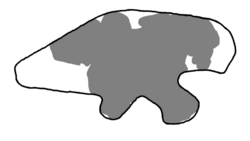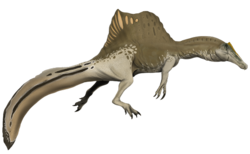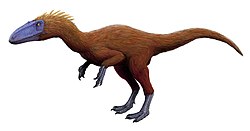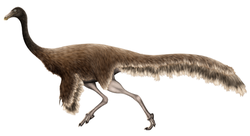Metriacanthosaurus
Metriacanthosaurus (meaning "moderately-spined lizard") is a genus of metriacanthosaurid dinosaur from the Oxford Clay Formation of England, dating to the Late Jurassic period, about 160 million years ago (lower Oxfordian). It is the only named metriacanthosaurid known outside of Asia.
History of discovery
The holotype of Metriacanthosaurus parkeri, specimen OUM J.12144, was discovered in 1871 by W. Parker at Jordan's Cliff, near Weymouth, Dorset, on the southwest coast of England.[1] The specimen includes an incomplete hip, a leg bone, and part of a backbone; the geologist John Phillips briefly commented on the specimen during the same year.[2] These bones were from the Oxford Clay Formation, which dates to the Upper Jurassic.[3]
In 1923, German paleontologist Friedrich von Huene wrote a paper on Jurassic and Cretaceous European carnivorous dinosaurs within Saurischia. In this paper, he examined OUM J.12144, assigning it to a new species of Megalosaurus: Megalosaurus parkeri.[1] The specific name honours W. Parker. In 1932, however, von Huene concluded it was a species of Altispinax, A. parkeri.[4]
In 1964, scientist Alick Walker decided these fossils were too different from Altispinax, as they lacked the long vertebral spines, and named the new genus Metriacanthosaurus.[5] The generic name is derived from Greek metrikos, "moderate", and akantha, "spine". Metriacanthosaurus thus gets its name from its vertebrae, which are taller than typical carnosaurs, like Allosaurus, but lower than other high-spined dinosaurs like Acrocanthosaurus.
Description
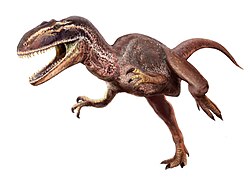
Metriacanthosaurus was a medium-sized theropod with a femur length of 80 cm (31 in). Gregory S. Paul in 1988 estimated its weight at 1 tonne (1.1 short tons).[6] Thomas Holtz gave a length of 8 meters (26.2 feet).[7] Metriacanthosaurus was named for the height of its neural spines, which are actually not overly tall for theropods.[3] They are similar to other theropods such as Megalosaurus, Sinraptor, and Ceratosaurus in being 1.5 times the height of the centrum.[8]
Classification
Originally named as a species of Megalosaurus in Megalosauridae, Metriacanthosaurus has since been reclassified in Metriacanthosauridae. It is thought to be related to genera such as Yangchuanosaurus, and in 1988 Paul synonymized the two genera. However, a 2007 review of British dinosaurs by Darren Naish and David Martill defending keeping the two genera taxonomically separate.[3] Metriacanthosaurus is considered a member of the subfamily Metriacanthosaurinae.[9]
Below is a simplified cladogram of Tetanurae by Matthew Carrano et al. (2012).[9]
Paleobiogeography and paleoecology

Metriacanthosaurus is the only known member of Metriacanthosauridae outside of Asia (other than possible fragmentary records from the geographically close Falaises des Vaches Noires locality of northern France, which is probably similar in age to Metriacanthosaurus[10]). The earliest records of metriacanthosaurids in Asia are from the early Middle Jurassic, with Metriocanthosaurus being nested within the diversity of Asian metriacanthosaurids. Metriacanthosaurus thus likely represents a dispersal event from Asia into Europe during the early Late Jurassic. Metriacanthosaurus appears to have lived alongside other large theropods belonging to the family Megalosauridae.[11] Other dinosaurs known from the Oxford Clay (which both spans the preceding Callovian and the Oxfordian) include the megalosaurid theropod Eustreptospondylus, the sauropod Cetiosauriscus, the stegosaurs Lexovisaurus and Loricatosaurus, the ankylosaur Sarcolestes, and the iguanodontian Callovosaurus.[12], with the poorly known ankylosaur Cryptosaurus also being known from Oxfordian aged sediments in Britain.[13][14] During this time, Europe formed an archipelago of islands surrounded by shallow seas, explaining the findings of these dinosaurs in marine sediments.[10]
References
- ^ a b von Huene, F. (1923). "Carnivorous Saurischia in Europe since the Triassic". Bulletin of the Geological Society of America. 34 (3): 449–458. Bibcode:1923GSAB...34..449V. doi:10.1130/GSAB-34-449.
- ^ J. Phillips. (1871). Geology of Oxford and the Valley of the Thames. Clarendon Press, Oxford
- ^ a b c Naish, Darren; Martill, David M. (2007). "Dinosaurs of Great Britain and the role of the Geological Society of London in their discovery: basal Dinosauria and Saurischia". Quarterly Journal of the Geological Society. 164 (3): 493–510. Bibcode:2007JGSoc.164..493N. CiteSeerX 10.1.1.394.9849. doi:10.1144/0016-76492006-032. S2CID 19004679.
- ^ von Huene, F. (1932). "Die fossile Reptil-Ordnung Saurischia, ihre Entwicklung und Geschichte". Monographien zur Geologie und Paläontologie. 1 (4): 361.
- ^ Walker, Alick D. (1964). "Triassic reptiles from the Elgin area: Ornithosuchus and the origin of carnosaurs". Philosophical Transactions of the Royal Society of London. Series B, Biological Sciences. 248 (744): 53–134. Bibcode:1964RSPTB.248...53W. doi:10.1098/rstb.1964.0009.
- ^ Paul, Gregory S. (1988). Predatory Dinosaurs of the World. New York: Simon & Schuster.
- ^ Holtz, Thomas R. Jr (2012). "Dinosaurs: The Most Complete, Up-to-Date Encyclopedia for Dinosaur Lovers of All Ages" (PDF).
- ^ Benson, R. B. J.; Radley, J. D. (2010). "A New Large-Bodied Theropod Dinosaur from the Middle Jurassic of Warwickshire, United Kingdom". Acta Palaeontologica Polonica. 55 (1): 35–42. CiteSeerX 10.1.1.601.354. doi:10.4202/app.2009.0083. S2CID 54680840.
- ^ a b Carrano, M. T.; Benson, R. B. J.; Sampson, S. D. (2012). "The phylogeny of Tetanurae (Dinosauria: Theropoda)". Journal of Systematic Palaeontology. 10 (2): 211–300. Bibcode:2012JSPal..10..211C. doi:10.1080/14772019.2011.630927. S2CID 85354215.
- ^ a b Monvoisin, Evariste; Allain, Ronan; Buffetaut, Eric; Picot, Laurent (2022-03-24). "New data on the theropod diversity from the Middle to Late Jurassic of the Vaches Noires cliffs (Normandy, France)". Geodiversitas. 44 (12). doi:10.5252/geodiversi-tas2022v44a12. ISSN 1280-9659.
- ^ Rauhut, Oliver W M; Bakirov, Aizek A; Wings, Oliver; Fernandes, Alexandra E; Hübner, Tom R (2024-08-01). "A new theropod dinosaur from the Callovian Balabansai Formation of Kyrgyzstan". Zoological Journal of the Linnean Society. 201 (4). doi:10.1093/zoolinnean/zlae090. ISSN 0024-4082.
- ^ "10.9 Cambridgeshire, England; 1. Lower Oxford Clay," in Weishampel, et al. (2004). Page 540.
- ^ Naish, Darren; Martill, David M. (May 2008). "Dinosaurs of Great Britain and the role of the Geological Society of London in their discovery: Ornithischia". Journal of the Geological Society. 165 (3): 613–623. Bibcode:2008JGSoc.165..613N. doi:10.1144/0016-76492007-154. ISSN 0016-7649.
- ^ "Great Gransden brick pit (Jurassic of the United Kingdom)". Paleobiology Database. Retrieved 2025-04-17.

